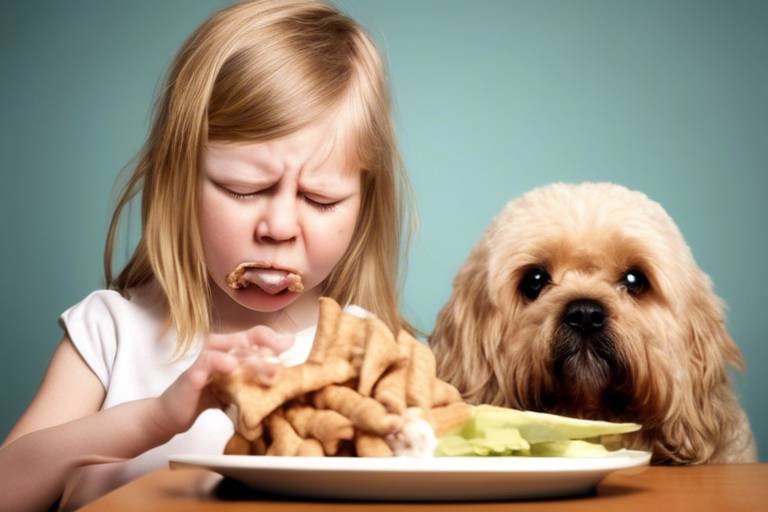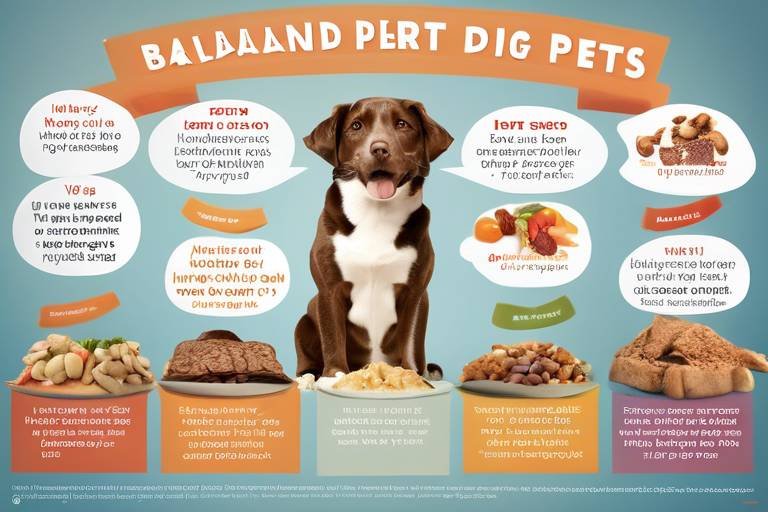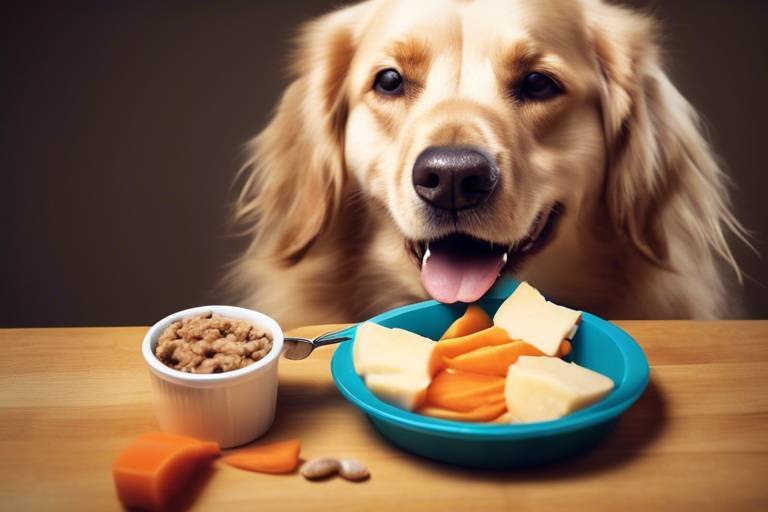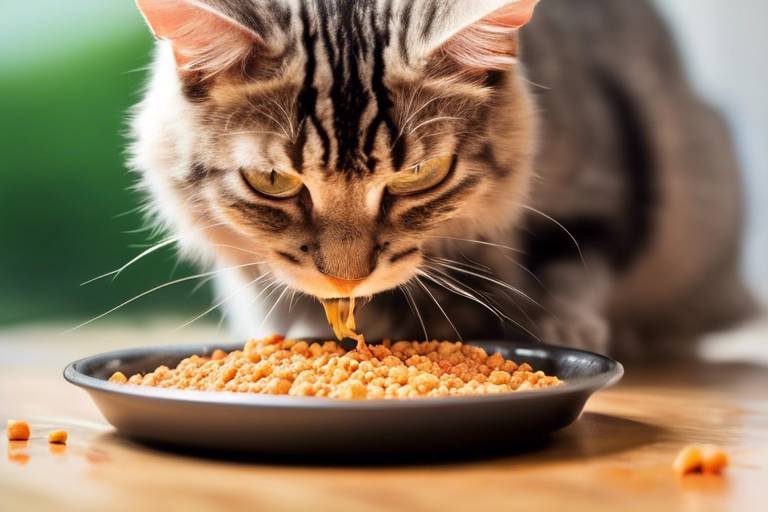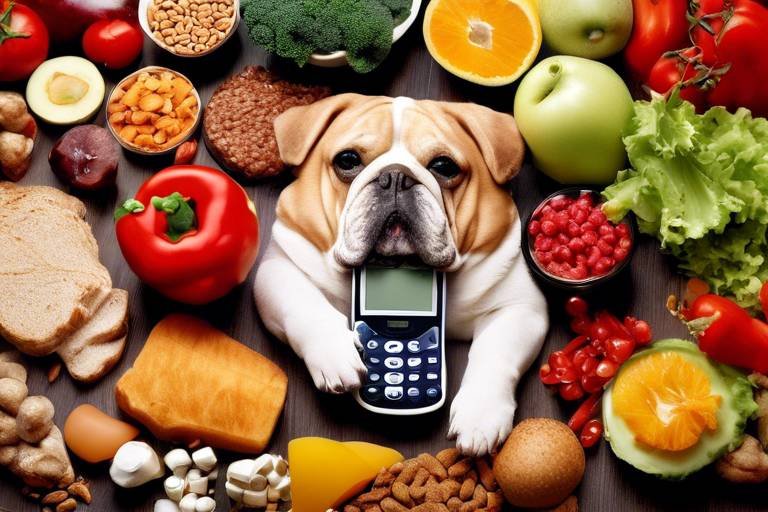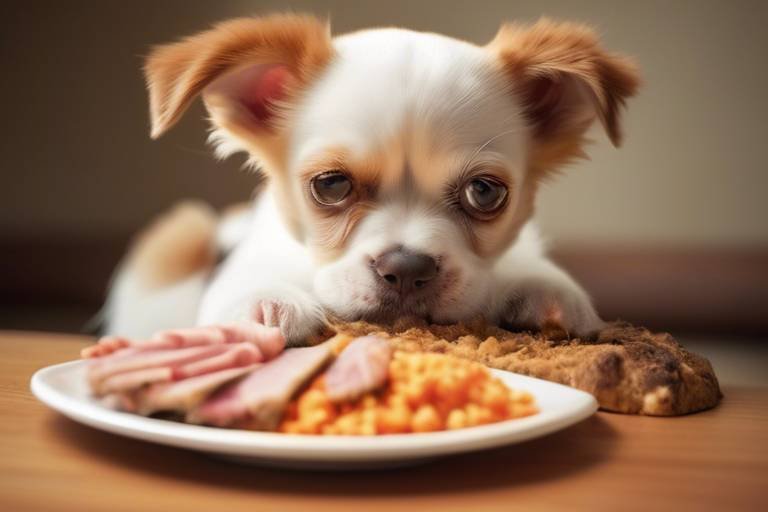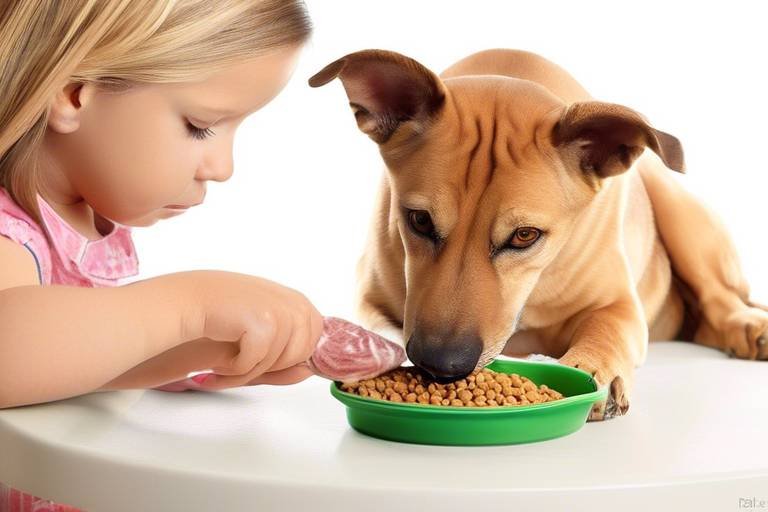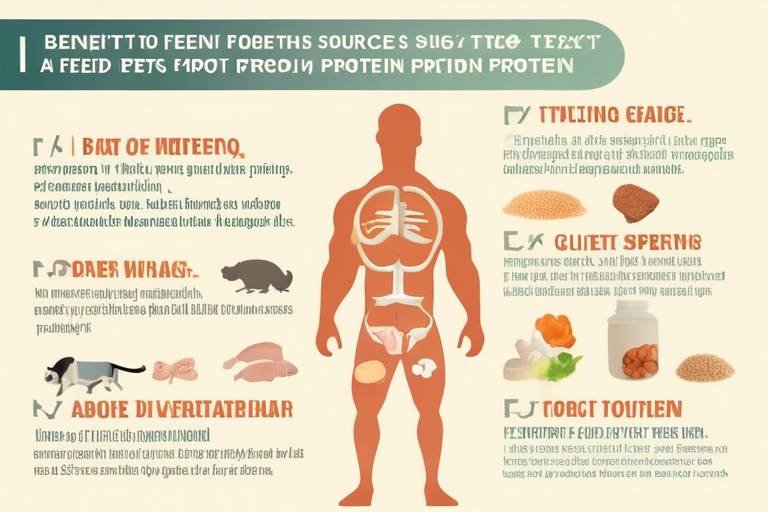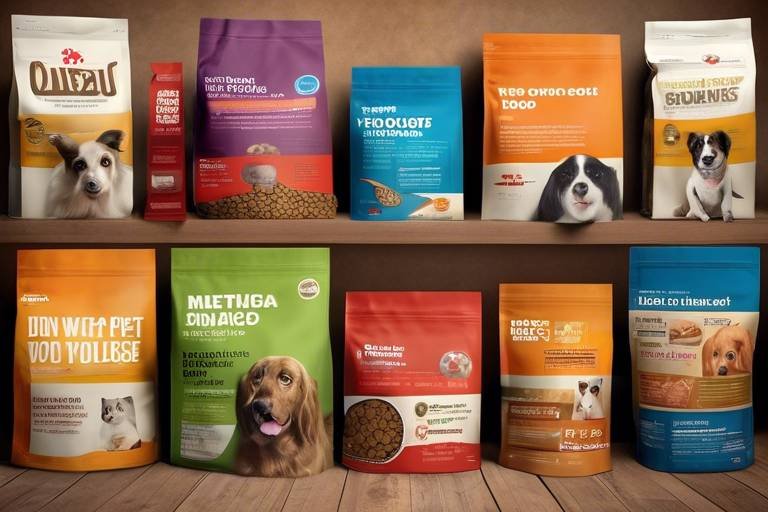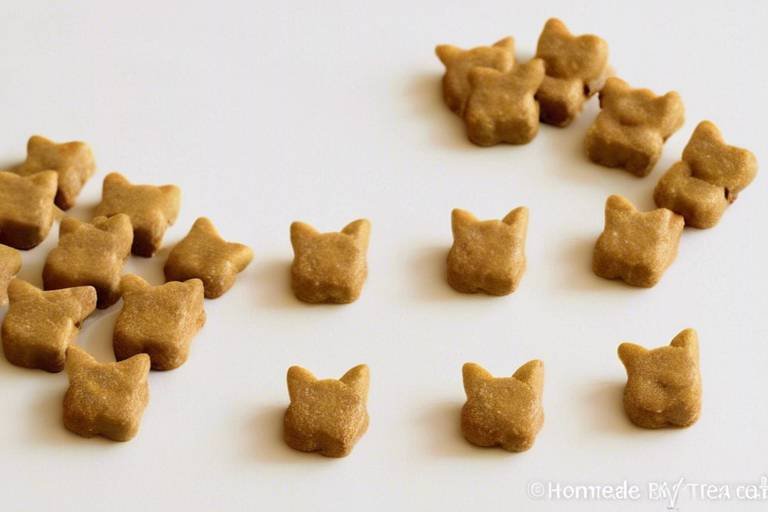How to Monitor Your Pet's Weight Effectively
As a pet owner, one of the most significant responsibilities you have is ensuring your furry friend maintains a healthy weight. Just like humans, pets can suffer from obesity, which can lead to a myriad of health issues. But how can you effectively monitor your pet's weight? It’s not just about stepping on a scale once in a while; it’s a comprehensive approach that involves regular assessments, dietary management, and physical activity. In this article, we will explore various techniques and tips to keep your pet's weight in check, allowing them to live a longer, healthier, and happier life.
Pet obesity is a growing concern among pet owners, and it’s more common than you might think. According to recent statistics, around 60% of cats and 56% of dogs in the United States are classified as overweight or obese. This alarming trend is primarily due to poor dietary choices, lack of exercise, and the misconception that pets should be fed based on their adorable pleading eyes. The consequences of obesity are severe and can lead to conditions such as diabetes, arthritis, and even heart disease. Understanding the factors that contribute to this issue is crucial in order to effectively monitor and manage your pet's weight.
Establishing a healthy weight goal for your pet is crucial. But how do you determine what that ideal weight should be? Factors such as breed, age, and health conditions all play a role. For instance, a Labrador Retriever has different weight standards compared to a Chihuahua. It’s essential to consult breed-specific guidelines and consider your pet’s unique characteristics. Additionally, a veterinarian can help you set realistic goals based on your pet’s current health status and lifestyle.
Your veterinarian is your best ally when it comes to managing your pet's weight. They can provide personalized recommendations tailored to your pet's needs. Regular check-ups allow for adjustments to your pet's diet and exercise plans based on their progress. This professional guidance is invaluable, as it ensures that your pet is losing weight safely and effectively, without compromising their health.
Routine veterinary visits are essential for monitoring your pet's weight and overall health. During these check-ups, the vet will assess your pet’s weight, body condition, and general health. It’s a great opportunity to discuss any concerns you might have and to receive tailored advice. Regular visits can help catch any potential issues early, making weight management much more effective.
The Body Condition Score (BCS) is a tool used to assess a pet's weight and overall health. It typically ranges from 1 to 9, with 1 being severely underweight and 9 being severely overweight. Understanding how to evaluate your pet using the BCS can help you monitor their weight more accurately. Here’s a simple breakdown:
| BCS Score | Description |
|---|---|
| 1 | Severely underweight |
| 4-5 | Ideal weight |
| 7-9 | Overweight to obese |
A balanced diet is key to maintaining a healthy weight. But with so many options available, how do you choose the right food? Start by looking for high-quality pet food that lists meat as the first ingredient. Pay attention to portion sizes and feeding schedules, as overfeeding can quickly lead to weight gain. It’s also important to avoid table scraps and unhealthy treats. Instead, opt for healthy snacks like carrots or specially formulated low-calorie treats. Remember, the goal is to create a diet that supports your pet's weight management while still being enjoyable.
Physical activity is vital for weight control. Just like us, pets need to burn off those extra calories! Incorporating daily exercise into your pet's routine can be as simple as taking them for a walk, playing fetch, or even engaging in interactive games. The key is to find activities that both you and your pet enjoy, making exercise a fun part of your daily routine.
Engaging your pet in fun activities can motivate them to exercise. Here are a few creative ideas:
- Obstacle courses in the backyard
- Hide and seek with their favorite toy
- Agility training with simple jumps and tunnels
These activities not only promote physical fitness but also strengthen the bond between you and your pet, making exercise a rewarding experience for both of you.
Monitoring your pet's weight over time is essential for effective management. Keep a log of their weight and note any changes in their diet or activity levels. Recognizing when adjustments are needed can be the difference between maintaining a healthy weight and falling into the trap of gradual weight gain. Regularly updating your pet’s progress will help you stay on track and make informed decisions about their health.
1. How often should I weigh my pet?
It's generally recommended to weigh your pet once a month. This frequency allows you to track any significant changes without being overly obsessive.
2. What should I do if my pet is overweight?
Consult your veterinarian for a tailored weight loss plan. This usually includes dietary changes and increased exercise.
3. Can I use human food as treats?
While some human foods are safe for pets, it’s crucial to avoid unhealthy options. Always check with your vet before introducing new foods.
4. How can I tell if my pet is at a healthy weight?
Using the Body Condition Score (BCS) is an excellent way to assess your pet’s weight. Your vet can also help determine if your pet is at a healthy weight.

Understanding Pet Obesity
Pet obesity has become a significant issue in recent years, affecting millions of furry companions worldwide. Just like humans, our pets can struggle with weight gain, leading to serious health problems. Did you know that according to the Association for Pet Obesity Prevention, over 50% of dogs and cats in the United States are classified as overweight or obese? That's a staggering statistic that highlights the urgent need for pet owners to monitor their pets' weight closely.
So, what causes pet obesity? The reasons can be multifaceted, often stemming from a combination of factors. Here are some common culprits:
- Overfeeding: Many pet owners tend to overestimate the amount of food their pets need. Treats can also add up quickly, contributing to excessive calorie intake.
- Lack of Exercise: In our busy lives, it's easy to overlook our pets' need for physical activity. A sedentary lifestyle can lead to weight gain.
- Genetics: Some breeds are more prone to obesity than others. Understanding your pet's breed can help you tailor their diet and activity levels accordingly.
- Age and Health Conditions: As pets age, their metabolism slows down, and they may require different dietary needs. Certain health issues, like hypothyroidism, can also contribute to weight gain.
The consequences of pet obesity are severe. Overweight pets are at a higher risk for numerous health issues, including diabetes, joint problems, and heart disease. Imagine your pet struggling to keep up during playtime or facing discomfort while walking. It's heartbreaking, isn't it? Moreover, obesity can significantly reduce your pet's lifespan. Just like a ticking time bomb, the longer the weight issue persists, the more likely it is to lead to serious health complications.
Statistics paint a vivid picture of this growing epidemic. Research indicates that obese pets are two to three times more likely to develop health issues compared to their normal-weight counterparts. This alarming trend emphasizes the importance of regular weight monitoring and intervention strategies. By keeping track of your pet's weight, you can help them lead a healthier, happier life.
In conclusion, understanding pet obesity is the first step toward prevention and management. As responsible pet owners, it's crucial to recognize the signs of weight gain, educate ourselves about the causes, and implement effective strategies to keep our furry friends healthy. Remember, a healthy pet is a happy pet!
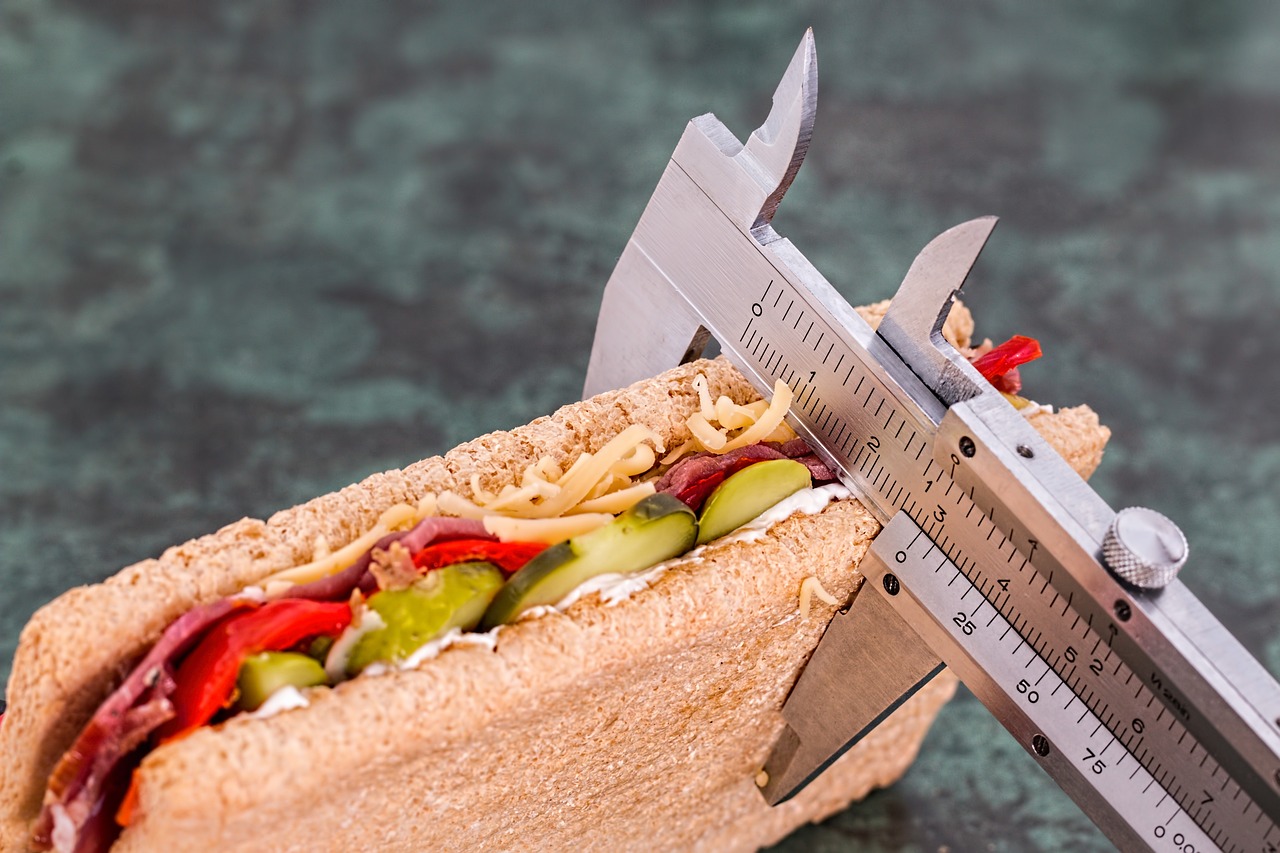
Setting a Healthy Weight Goal
Establishing a healthy weight goal for your pet is not just a good idea; it's essential for their overall well-being. Think of it as setting a roadmap for their health journey. Just like we have different ideal weights based on our body types and lifestyles, pets also have their unique requirements. But how do you determine what that ideal weight is? It can be a bit tricky, but it’s worth the effort!
First, consider your pet's breed and size. Different breeds have different standards for what constitutes a healthy weight. For instance, a Labrador Retriever will have a different ideal weight range than a Chihuahua. To make this clearer, here's a simple table that breaks down some common breeds and their ideal weight ranges:
| Breed | Ideal Weight (lbs) |
|---|---|
| Labrador Retriever | 55-80 |
| Beagle | 20-30 |
| Chihuahua | 2-6 |
| German Shepherd | 50-90 |
| Persian Cat | 7-12 |
Next, age and health conditions play a crucial role in setting that weight goal. A young, active pet will have different needs compared to an older, less active one. For example, senior pets may need to maintain a slightly lower weight to reduce stress on their joints. It’s like how we adjust our diets as we age; our pets need the same consideration.
Now, you might be wondering, "How can I find out my pet's ideal weight?" The best way is to consult your veterinarian. They can provide personalized recommendations based on your pet's specific breed, age, and health status. Regular check-ups are vital because they allow for ongoing adjustments to your pet's weight management plan. This professional guidance is like having a coach for your pet's health journey—someone who knows the ins and outs of what your furry friend needs!
In addition to veterinary advice, keeping track of your pet's Body Condition Score (BCS) can be incredibly helpful. The BCS is a visual assessment tool that helps you evaluate your pet's body fat and overall condition. It ranges from 1 to 9, with 1 being emaciated and 9 being obese. Aim for a score of around 4 to 5, which indicates a healthy weight. Think of BCS as a scorecard for your pet's health; it gives you a clear picture of where they stand and what adjustments might be necessary.
In conclusion, setting a healthy weight goal for your pet involves a combination of understanding their breed, age, health conditions, and professional guidance. It’s not just about numbers on a scale; it’s about ensuring your pet lives a long, happy, and healthy life. Remember, keeping your pet at a healthy weight is a team effort between you, your vet, and of course, your furry friend!
- How often should I weigh my pet? It's a good idea to weigh your pet at least once a month to monitor any significant changes.
- What should I do if my pet is overweight? Consult your veterinarian to create a tailored weight loss plan, which may include diet changes and increased exercise.
- Can certain breeds be more prone to obesity? Yes, some breeds are genetically predisposed to gain weight, so it's crucial to monitor their diet and activity closely.
Consulting Your Veterinarian
When it comes to your pet's health, consulting your veterinarian is like having a trusted co-pilot on a journey to wellness. They possess a wealth of knowledge that can guide you in establishing a weight management plan tailored specifically for your furry friend. Just like we have unique health needs, pets do too! Your vet can provide insights based on your pet's breed, age, and any existing health conditions that might affect their weight.
Regular visits to the vet are essential, and it’s not just about vaccinations or check-ups. During these appointments, your veterinarian will assess your pet’s overall health and discuss any concerns you might have regarding their weight. They may even perform a Body Condition Score (BCS) assessment, which is a fantastic tool for determining whether your pet is underweight, at a healthy weight, or overweight. This score takes into account factors like body shape and fat coverage, giving you a clearer picture of your pet's health.
Moreover, your veterinarian can help you set realistic weight goals. For instance, if your cat is a bit on the heavy side, your vet can recommend a target weight based on their ideal body condition. This is crucial because, just like humans, pets can experience health issues related to obesity, such as diabetes, joint problems, and heart disease. By working closely with your vet, you can create a comprehensive weight management plan that includes dietary changes and exercise recommendations tailored to your pet's specific needs.
It’s also important to keep an open line of communication with your vet. If you notice any sudden changes in your pet's weight or behavior, don’t hesitate to reach out. Your veterinarian can help you navigate these changes and adjust the weight management plan as necessary. Remember, your pet relies on you for their well-being, and your vet is your best ally in ensuring they lead a happy, healthy life.
In summary, regular consultations with your veterinarian are vital for effective weight management in pets. They provide personalized recommendations, conduct essential health assessments, and help you set achievable health goals. So, don’t overlook those vet visits; they are a crucial part of your pet's journey to a healthier weight!
- How often should I take my pet to the vet for weight checks? It is recommended to have your pet checked at least once a year, but more frequent visits may be needed for pets that are overweight or have health issues.
- What is the Body Condition Score? The Body Condition Score is a scale that helps assess a pet's body fat and overall health, guiding you on whether your pet is underweight, at a healthy weight, or overweight.
- Can I manage my pet's weight without a vet? While you can make dietary changes and encourage exercise at home, it’s best to involve a veterinarian for a tailored plan and to avoid potential health risks.
- What should I do if my pet is overweight? Consult your veterinarian for a weight management plan that includes dietary adjustments and an exercise regimen suitable for your pet's specific needs.
Regular Health Check-ups
Regular health check-ups are not just a routine; they are a vital component of your pet's weight management journey. Think of these visits as a preventive measure that can save you from potential health issues down the road. During these check-ups, veterinarians can assess your pet's weight, body condition, and overall health status, ensuring that your furry friend is on the right track.
When you take your pet for a check-up, it's essential to be prepared. You might want to track your pet's weight history and any changes in behavior or appetite. This information can help the veterinarian make informed recommendations tailored to your pet's needs. Typically, a health check-up includes:
- Weight Measurement: Regularly tracking your pet's weight allows for early detection of any significant changes.
- Body Condition Score Assessment: This helps in evaluating whether your pet is underweight, at a healthy weight, or overweight.
- General Health Evaluation: The vet will check vital signs and assess overall health, looking for any signs of illness or discomfort.
- Dietary Recommendations: Based on the findings, your vet can suggest dietary adjustments to help maintain or achieve a healthy weight.
Moreover, these visits are an excellent opportunity to discuss any concerns you might have regarding your pet's behavior or lifestyle. Whether it’s about their eating habits or exercise routine, your veterinarian can provide valuable insights and tips. Remember, a proactive approach is always better than a reactive one. Regular health check-ups not only keep your pet healthy but also strengthen the bond between you and your veterinarian, ensuring that your furry companion receives the best possible care.
In conclusion, don't underestimate the importance of routine veterinary visits. They are essential for effective weight management and overall health. Just like you wouldn’t skip your own health check-ups, your pet deserves the same level of attention and care!
Q1: How often should I take my pet for a health check-up?
A: It's generally recommended to take your pet for a check-up at least once a year. However, older pets or those with health issues may require more frequent visits.
Q2: What should I do if my pet is overweight?
A: Consult your veterinarian for a personalized weight management plan, which may include dietary changes and increased exercise.
Q3: Can I monitor my pet's weight at home?
A: Yes, you can weigh your pet at home using a scale, but it’s essential to keep a consistent record and discuss the results with your vet.
Q4: What are some signs my pet might be overweight?
A: Common signs include difficulty in breathing, reluctance to exercise, and difficulty in feeling their ribs. Regular vet check-ups can help identify these issues early.
Understanding Body Condition Score (BCS)
The Body Condition Score (BCS) is a vital tool that helps pet owners assess their furry friends' weight and overall health. Think of it as a simple grading system that provides insights into whether your pet is underweight, ideal, or overweight. The BCS typically ranges from 1 to 9, where a score of 1 indicates an extremely underweight pet, while a score of 9 suggests severe obesity. Understanding this scoring system is crucial for maintaining your pet's health and longevity.
To determine your pet's BCS, you can perform a simple evaluation at home. Gently run your hands along your pet's sides. You should be able to feel their ribs without excess fat covering them; if you can't, it may indicate that your pet is overweight. Additionally, you should notice a visible waist when looking from above. This visual cue is important because it reveals whether your pet is carrying extra weight.
Here’s a brief breakdown of the BCS scale:
| Score | Description |
|---|---|
| 1 | Severely underweight, ribs and bones are visible |
| 2 | Underweight, ribs easily felt, minimal fat |
| 3 | Ideal weight, ribs can be felt but not seen |
| 4 | Overweight, ribs not easily felt, slight fat |
| 5 | Obese, ribs are not felt, significant fat |
| 6 | Severely obese, heavy fat deposits |
| 7 | Extremely obese, very difficult to assess |
| 8 | Morbidly obese, health risks are high |
| 9 | Severe obesity, immediate veterinary intervention needed |
It's essential to regularly monitor your pet's BCS, as fluctuations can indicate changes in health, diet, or activity levels. If you notice a change in your pet's score, it might be time to consult your veterinarian for personalized advice. They can provide insights into how to adjust your pet's diet or exercise routine to achieve a healthier weight.
By understanding and utilizing the Body Condition Score, you're taking a proactive step towards ensuring your pet lives a healthy, happy life. Remember, a healthy weight not only enhances your pet's quality of life but also increases their lifespan. So, keep an eye on that score and make adjustments as necessary!
- What should I do if my pet is overweight? If your pet is overweight, consult your veterinarian for a tailored weight loss plan, which may include dietary changes and increased exercise.
- How often should I check my pet's weight? It's a good practice to check your pet's weight monthly, but more frequent checks may be necessary if they are on a weight loss program.
- Can I use the BCS for all pet breeds? Yes, the BCS can be applied to most dog and cat breeds, although some breeds may have specific weight considerations.
Implementing a Balanced Diet
When it comes to keeping your furry friend healthy, is absolutely crucial. Just like us, pets need a variety of nutrients to thrive, and a well-rounded diet can help prevent obesity while ensuring they have the energy to play and enjoy life. But what does a balanced diet look like for your pet? It’s not just about filling their bowl; it’s about choosing the right foods in the right proportions.
First things first, consider the type of food you’re feeding your pet. There are many options available, including dry kibble, wet food, and even homemade diets. Each type has its pros and cons, but the key is to choose high-quality food that meets the nutritional standards set by pet food regulatory bodies. Look for products that list meat as the first ingredient and avoid those with excessive fillers like corn and soy. Remember, you are what you eat, and the same goes for your pet!
Next, let’s talk about portion sizes. Overfeeding is a common mistake among pet owners, often stemming from the adorable pleading eyes of a hungry pet. To avoid this, you should refer to the feeding guidelines provided on the pet food packaging, which usually take into account your pet's weight and activity level. However, these are just starting points. You might need to adjust based on your pet’s individual needs, which can vary greatly. For instance, a more active dog may require more calories than a couch potato. Regularly monitoring your pet’s weight will help you fine-tune their portions.
Another important aspect of a balanced diet is the feeding schedule. Establishing a routine can help regulate your pet’s metabolism and prevent overeating. Most pets do well with two meals a day, but some might thrive on three smaller meals. This not only helps keep their energy levels stable but also makes it easier for you to monitor their food intake. To make it even easier, consider using a measuring cup or a food scale—this way, you can ensure that your pet is getting just the right amount.
Lastly, don’t forget to incorporate healthy treats into your pet’s diet. While it’s tempting to spoil them with table scraps or store-bought snacks, opt for healthier alternatives. Fresh fruits and vegetables like carrots, green beans, or apple slices can be great low-calorie treats that your pet will love. Just be sure to check which foods are safe for your particular pet, as some can be harmful.
In summary, a balanced diet for your pet is about more than just feeding them; it’s about making informed choices that cater to their specific needs. By selecting high-quality food, paying attention to portion sizes, establishing a feeding routine, and choosing healthy treats, you’ll be well on your way to supporting your pet’s health and preventing obesity. Remember, a healthy pet is a happy pet!
- What should I look for in pet food? Look for high-quality ingredients, with meat as the first ingredient, and avoid fillers.
- How do I determine the right portion size for my pet? Refer to the feeding guidelines on the food packaging and adjust based on your pet's weight and activity level.
- Can I give my pet human food? Some human foods are safe for pets, like fruits and vegetables, but always check which foods are appropriate.
- How often should I feed my pet? Most pets do well with two meals a day, but some may benefit from three smaller meals.

Incorporating Regular Exercise
When it comes to keeping our furry friends healthy, exercise is just as important as a balanced diet. Think of it this way: just like we need to stretch our legs and get our blood pumping, our pets also require regular physical activity to stay fit and happy. But how do you ensure that your pet is getting enough exercise? Well, it’s simpler than you might think!
First off, you need to consider your pet's breed, age, and overall health. For instance, a young Labrador might be bursting with energy and require long walks or even runs, while a senior Chihuahua may prefer gentle strolls around the block. Understanding your pet's unique needs is the first step in creating a successful exercise routine.
One of the best ways to incorporate regular exercise into your pet's life is to establish a daily routine. Just like we thrive on habits, pets do too! Aim for at least 30 minutes of activity each day. This could be split into two or three shorter sessions, depending on your pet's stamina. Here’s a quick breakdown of some fun and engaging activities you can try:
- Walks: A simple walk around the neighborhood can do wonders. Vary the route to keep things interesting!
- Fetch: This classic game is not only fun but also a great way to get your pet moving.
- Agility Training: Set up a mini obstacle course in your backyard for some serious fun and exercise.
- Doggy Playdates: Socializing with other dogs can lead to playful bouts of running and chasing.
Now, let’s not forget about the importance of mental stimulation in your pet's exercise routine. Engaging their minds can be just as tiring as physical activity! Consider incorporating puzzle toys or training sessions that challenge them to think. This not only helps with weight management but also keeps your pet sharp and focused.
Additionally, remember to keep it fun! If your pet enjoys what they’re doing, they’ll be more likely to stay active. Try mixing things up with new toys or activities. For example, if your dog loves water, take them to a dog-friendly beach or lake for a swim. Swimming is an excellent low-impact exercise that many pets adore!
Lastly, always keep an eye on your pet's body language during exercise. If they seem tired or reluctant, it might be time to take a break. Just like us, pets can overdo it, and it's crucial to listen to their needs. By being attentive and adjusting their routine as necessary, you can ensure a healthy, happy, and active lifestyle for your beloved companion.
Q: How much exercise does my pet need?
A: Most pets require at least 30 minutes of exercise each day, but this can vary based on breed, age, and health. Always consult with your veterinarian for personalized advice.
Q: What are some signs that my pet is getting enough exercise?
A: Signs include a healthy weight, good muscle tone, and a happy demeanor. If your pet seems restless or bored, they might need more activity!
Q: Can I exercise my pet indoors?
A: Absolutely! Indoor activities like fetch, tug-of-war, or using puzzle toys are great ways to keep your pet active, especially during bad weather.
Fun Activities for Pets
Engaging your furry friends in fun activities is not just a way to keep them active; it’s also an opportunity to strengthen the bond between you and your pet. Just like humans, pets enjoy variety and excitement in their daily routines. Imagine your pet's face lighting up with joy as they engage in something new! This section will explore some creative and enjoyable activities that can keep your pet physically fit and mentally stimulated.
One of the simplest ways to get your pet moving is through interactive playtime. Whether you have a dog or a cat, playing with toys can be a fantastic way to encourage exercise. For dogs, consider using a frisbee or a ball. Not only does this get them running, but it also taps into their natural instincts. For cats, feather wands or laser pointers can provide hours of entertainment. Remember, the goal is to make it enjoyable for both of you!
Additionally, you can introduce your pets to obstacle courses. This can be as simple as setting up cushions and boxes in your living room or using items in your backyard. Create a mini agility course where your dog can jump over hurdles or weave through cones. Cats can also enjoy climbing structures or tunnels that stimulate their curiosity and encourage them to explore. You might be surprised at how quickly they take to these challenges!
Don't forget about group activities! Joining a local pet club or participating in community events can be a great way to socialize your pet while ensuring they get their exercise. Many communities host dog parks or pet-friendly events that allow pets to interact and play with others. This not only provides physical activity but also enriches your pet's social skills.
For those who want to take it up a notch, consider training classes. These classes not only teach your pet new tricks but also provide an excellent outlet for energy. Imagine teaching your dog to roll over or your cat to high-five! Training sessions can be incredibly rewarding for both pets and their owners. Plus, they can help improve your pet's obedience and behavior.
Finally, remember that the most important part of any activity is that it should be enjoyable. Pay attention to your pet’s reactions; if they seem bored or disinterested, switch things up! The more fun and engaging the activities, the more likely your pet will look forward to them. After all, a happy pet is a healthy pet!
Q: How often should I engage my pet in fun activities?
A: Ideally, you should aim for at least 30 minutes of active playtime each day, but this can vary based on your pet's age, breed, and energy level.
Q: What are some signs my pet is enjoying the activity?
A: Look for signs like wagging tails, playful barks or meows, and an eagerness to engage. If your pet is actively participating and seems excited, they are likely enjoying the activity!
Q: Can indoor activities be just as beneficial as outdoor ones?
A: Absolutely! Indoor activities can be just as effective, especially for pets that may not have access to outdoor spaces. Just ensure that the environment is safe and free from hazards.
Tracking Progress
Monitoring your pet’s weight is not just a one-time activity; it's an ongoing journey that requires diligence and consistency. Just like we keep track of our own health metrics, keeping an eye on your furry friend's weight can help you make timely adjustments to their diet and exercise routine. So, how do you effectively track your pet's weight? Let's delve into some practical methods!
First and foremost, consider establishing a weight log. This can be as simple as a notebook or a digital document where you record your pet's weight on a regular basis. Ideally, you should weigh your pet at least once a month, but weekly weigh-ins can provide even more insight, especially if you're making significant changes to their diet or exercise. By documenting these changes, you can visualize trends over time, which can be incredibly motivating. You might be surprised at how quickly those little changes add up!
To make this process even more straightforward, you could create a
| Date | Weight (lbs) | Notes |
|---|---|---|
| 01/01/2023 | 25 | Beginning of diet |
| 01/15/2023 | 24.5 | Increased activity |
| 02/01/2023 | 24 | Maintaining diet plan |
Next, don’t forget to pay attention to your pet’s Body Condition Score (BCS). This scoring system helps you assess whether your pet is underweight, at a healthy weight, or overweight. Regularly evaluating your pet using BCS can provide a more comprehensive understanding of their overall health beyond just the number on the scale. For instance, a pet might weigh the same but could have gained muscle mass, which is a positive change!
Additionally, it’s crucial to recognize when to make adjustments. If your pet is not losing weight as expected despite your efforts, it might be time to revisit their food portion sizes or increase their physical activity. On the other hand, if they are losing weight too quickly, that could also be a cause for concern. Always keep an open line of communication with your veterinarian during this process. They can help you interpret the data you’ve collected and guide you on the next steps.
In conclusion, tracking your pet's weight should be an engaging and proactive part of their care routine. With the right tools, such as a weight log and BCS assessments, you can ensure that your beloved companion remains in tip-top shape. And remember, every little bit counts! Celebrate the small victories along the way, whether it’s a pound lost or a more energetic playtime. Your pet's health is a journey, and you’re in it together!
- How often should I weigh my pet? It's recommended to weigh your pet at least once a month, but weekly weigh-ins can provide more detailed insights.
- What is the Body Condition Score (BCS)? BCS is a scoring system used to assess your pet's body fat and overall health, helping determine if they are underweight, at a healthy weight, or overweight.
- What should I do if my pet is losing weight too quickly? Consult your veterinarian immediately to evaluate the underlying causes and adjust their diet or healthcare plan as necessary.
- Can I track my pet’s weight using a smartphone app? Absolutely! There are several apps available designed specifically for pet health management that can help you log and track your pet's weight and health metrics.
Frequently Asked Questions
- What is pet obesity and why is it a concern?
Pet obesity is a serious health issue that occurs when pets carry excess body weight. This condition can lead to various health problems, including diabetes, joint issues, and heart disease. It's a growing concern among pet owners because it can significantly shorten a pet's lifespan and affect their quality of life.
- How can I determine my pet's ideal weight?
To determine your pet's ideal weight, you can consult with your veterinarian, who can provide breed-specific recommendations. Generally, you should consider factors like your pet's age, size, and overall health. There are also Body Condition Score (BCS) charts available that help assess whether your pet is underweight, healthy, or overweight.
- What role does diet play in managing my pet's weight?
A balanced diet is crucial for maintaining a healthy weight in pets. Choosing the right food, understanding portion sizes, and establishing a consistent feeding schedule can help prevent obesity. It's important to avoid overfeeding and to select high-quality pet food that meets your pet's specific nutritional needs.
- How often should I take my pet to the veterinarian for weight checks?
Regular veterinary check-ups are essential for monitoring your pet's weight and overall health. Ideally, you should schedule visits at least once a year, but if your pet is overweight or has specific health concerns, more frequent visits may be necessary. Your vet can help you track your pet's progress and make any needed adjustments to their diet or exercise routine.
- What types of exercises are suitable for my pet?
Exercise needs can vary based on your pet's age, breed, and health. Generally, dogs benefit from daily walks, playtime in the yard, or games like fetch. Cats can be engaged with interactive toys, climbing structures, or laser pointers. The key is to find fun activities that keep your pet moving and excited about exercise!
- How can I track my pet's weight progress effectively?
Tracking your pet's weight can be done by regularly weighing them at home or during vet visits. Keeping a log of their weight over time can help identify trends and when adjustments may be necessary. Additionally, monitoring their Body Condition Score can provide valuable insights into their overall health and weight management.
- What fun activities can I do with my pet to encourage exercise?
There are plenty of fun activities you can do with your pet to promote exercise! Consider playing tug-of-war, setting up an obstacle course, or taking them for a hike. Engaging in these activities not only helps with weight management but also strengthens the bond between you and your furry friend.


